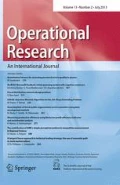Abstract
This study compares two popular jump diffusion models using equity data from the Greek market. The models considered are those proposed by Merton (1974) and Kou (2002) and differ on the specification of the jump component. In the former model jumps follow a lognormal distribution whereby in the latter the jump component is drawn from a double exponential distribution. Maximum Likelihood estimation provides evidence of jumps in both basket indices and individual stock returns. Moreover, the empirical comparison shows that double exponential jumps are more consistent with the empirical data.
Similar content being viewed by others
References
Ait-Sahalia, Y. (2004). “Disentangling Diffusion from Jumps”,Journal of Financial Economics, 74, 487–528.
Andersen, T.G., Benzoni, L., and Lund, J. (2002). “An Empirical Investigation of Continuous-Time Equity Return Models”,Journal of Finance, 57, 1239–1283.
Ball, A. C., and Torous W. N. (1985). “On Jumps in Common Stock Prices and Their Impact on Call Option Pricing”,Journal of Finance, 40, 155–173.
Bates, D. (1991). “The Crash of ’87: Was It Expected? The Evidence from Options Markets”,Journal of Finance, 46, 1009–1044.
Bates, D. (1996). “Jumps and Stochastic Volatility: Exchange Rate Processes Implicit in Deutsche Mark Options”,Review of Financial Studies, 9, 69–107.
Bates, D. (2000). “Post-87 Crash Fears in S&P 500 Futures Options”,Journal of Econometrics, 94, 181–238.
Broadie, M., Chernov, M., and Johannes, M. (2004). “Model Specification and Risk Premiums: The Evidence from the Futures Options”, forthcomingJournal of Finance.
Chacko, G. and Viceira, L. (2003). “Spectral GMM Estimation of Continuous-Time Processes”,Journal of Econometrics, 116, 259–292.
Duffie, D., Pan, J., and Singleton, K. (2000). “Transform Analysis and Asset Pricing for Affine Jump-Diffusions”,Econometrica, 68, 1343–1376.
Eraker, B. (2004). “Do Stock Prices and Volatility Jump? Reconciling Evidence from Spot and Option Prices”,Journal of Finance, 59, 1367–1403.
Eraker, B., Johannes M., and Poison N. (2003). “The Impact of Jumps in Volatility and Returns”,Journal of Finance, 53, 1269–1300.
Green W.H. (2000). Econometric Analysis, Prentice Hall International, Inc. Honoré, P. (1998). “Pitfalls in Estimating Jump Diffusion Models”, Working Paper, Aarhus University.
Jarrow, R., and Rosenfeld, E. (1984). “Jump Risks and the Intertemporal Capital Asset Pricing Model”, Journal of Business, 57, 114–135.
Jorion, P. (1988). “On Jump Processes in the Foreign Exchange and Stock Markets”,Review of Financial Studies, 1, 427–445.
Kou, S. G. (2002). “A Jump-Diffusion Model for Option Pricing”,Management Science, 48 1086–1101.
Kou, S. G. and Wang, H. (2004). “Option Pricing Under a Double Exponential Jump Diffusion Model”,Management Science, 50, 1178–1192.
Kushner, H.J. (1967). Stochastic Stability and Control, New York: Academic Press.
Merton, R. C. (1976). “Option Pricing when Underlying Stock Returns are Discontinuous”,Journal of Financial Economics, 3, 125–144.
Naik, V., and Lee, M. (1990). “General Equilibrium Pricing of Options on the Market Portfolio with Discontinuous Returns”.Review of Financial Studies, 3, 493–521.
Pan, J. (2002). “The Jump-Risk Premia Implicit in Options: Evidence from an Integrated Time-Series Study”,Journal of Financial Economics, 63, 3–50.
Petrella, G., and S. G. Kou (2004). “Numerical Pricing of Discrete Barrier and Lookback Options via Laplace Transforms”,Journal of Computational Finance, 8, 1–37.
Ramezani, C. A., and Zeng, Y. (2004). “An Empirical Assesment of the Double Exponential Jump Diffusion Model”,Working paper, Department of Statistics, University of Wisconsin, Madison, WI.
Singleton, K. (2001). “Estimation of Affine Asset Pricing Models Using the Empirical Characteristic Function”,Journal of Econometrics, 102, 111–141.
Yu, J. (2004). “Empirical Characteristic Function Estimation and Its Applications”,Econometric Reviews, 23, 93–123.
Zhou, C. (2001). “The Term Structure of Credit Spreads with Jump Risk”,Journal of Banking and Finance, 25, 2015–40
Author information
Authors and Affiliations
Corresponding author
Additional information
George Dotsis acknowledges financial support from the IRAKLITOS Research Fellowship Program financed by the Greek Ministry of Education and the European Union.
Rights and permissions
About this article
Cite this article
Dotsis, G., Psychoyios, D. & Markellos, R.N. Modeling Greek equity prices using jump diffusion processes. Oper Res Int J 6, 129–143 (2006). https://doi.org/10.1007/BF02941228
Issue Date:
DOI: https://doi.org/10.1007/BF02941228




